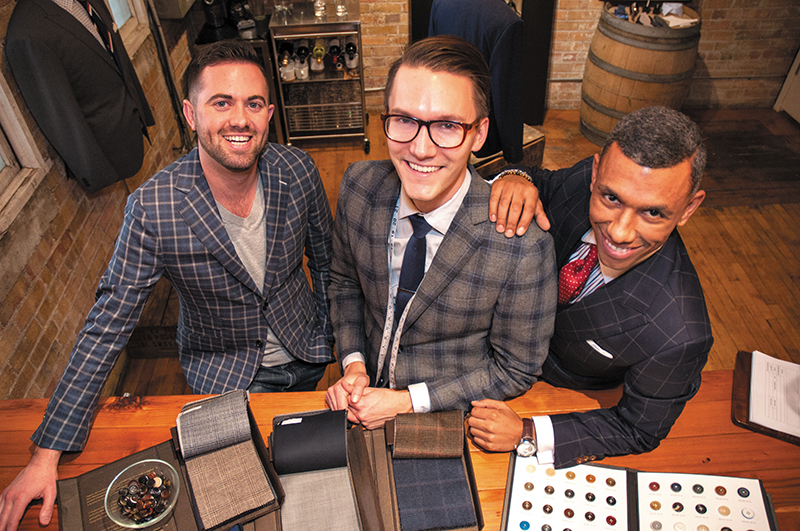
Talking Pins & Needles with The Tailor Cooperative
Art
Tailor Cooperative is a fairly new addition to the growing creative community on Pierpont Avenue. They set up shop in May 2016 and seized the opportunity to tailor quality-made suits in the local market. Only three people run The Tailor Cooperative, Co-founders Adam Malmborg and Chase Murdock and Personal Tailor Eduardo Xavier. Both owners have travelled abroad extensively, coming across robust tailoring businesses. Murdock, who spent time in Southeast Asia, became familiar with their tailoring practices. Though he admits that the quality was a bit underwhelming, the experience was one he wanted to bring home to the U.S. “Tailoring is a lost art here in the U.S.,” says Murdock. “There aren’t a lot of corner-shop tailors. There’s certainly not a place where you can go and get a suit made, and they know you on a first-name basis; [where] they keep your pattern on file and they know your style preferences.” To address this, The Tailor Cooperative seeks to provide just that with a more upscale experience.
Tailor Cooperative is ready to fit customers with a new, high-quality suit. Upon entering, clients will find themselves presented with various styles and colors of suits, jackets, ties and shirts that display their craftsmanship. Keeping it old school, the gentlemen at Tailor Cooperative are dressed to impress when sitting down with prospective clients—jazz playing in the background—to talk style. This is part of a four-step process to provide the customer with a suit that will last a lifetime. “What we do is set aside about an hour and a half with each customer and really take them through all the details,” Malmborg says. This includes going over what the ensemble is for, with the purpose of letting the customer design their own suit. The process entails that the customer thumbs through books of fabrics and linings. There is a wide variety to choose from, such as the tan Worsted Will, the deep-blue Solid Navy or the subtly sharp Grey Pin Stripe. The client then chooses, on a one-through-five fit scale, where the suit can be very slim (1) or very loose (5). After 25 body measurements are taken, the suit is then set to be laser cut. “We build using those measurements, so it’s a perfect fit,” Malmborg says.
The suit is sent off to a factory in Shanghai to be put together. After four to six weeks, the customer returns to Tailor Cooperative for a second fitting. During this fitting, the assigned tailor works with the client to get a better feel for what the customer expects from their custom suit. A few weeks after, the client goes through a third fitting. Murdock says, “Hopefully, that’s the final fitting, but we have a perfect-fit guarantee, which means [that] if we have to go through seven fittings to get it right, we’ll do it.” Such precision is not commonly found with suits purchased at other stores. While alterations can be made to pre-made suits, they will never have the perfect fit.
According to Murdock, this is the reason that a custom suit is popular. Such care and craftsmanship can impact the appearance of an expensive suit, when in reality, it may actually be inexpensive and just fit very well. “I think what we emphasize is a European approach to suits—so craftsmanship and fit,” says Murdock. These suits are not meant to be used for just one season, like something bought at a trendy, fast-fashion chain store. Tailor Cooperative provides suits that can one day be handed down to the next generation. Some materials they use include canvas suits, imported shoulder pads and bullhorn buttons. “We joke with our clients, ‘You’ll be handing this down to your kid one day if you take care of it right,’” Murdock says.
According to Murdock, the style of suits doesn’t really change that much over time. “When we talk about the most extravagant suit we’ve ever made and compare it to the most conservative suit we’ve ever made, we’re talking very subtle differences,” he says. Due to a suit’s longevity, Murdock further suggests that most clients are reluctant to go with something that is too vogue. Taking this into account, Tailor Cooperative remains largely open toward what the customer desires, and will work with them to find their perfect fit. Murdock and Malmborg will, however, educate their clients on the kind of suit they are seeking. For example, if a client enters the shop wanting a black suit thinking it’s a conservative look and good for interviews, they will point out that the black suit’s use is for a more formal setting—like a funeral or wedding—and then direct them toward a style such as a charcoal suit, which would be more appropriate.
The gentlemen at Tailor Cooperative are passionate and knowledgeable about their craft. Between the three of them, they boast some impressive relationships with fabric mills worldwide. Murdock says, “Our entire business model is direct to consumer, direct to factory,” says Murdock. Other businesses see fabric change hands at least several times before the product is made. The result is an end product that tends to be more expensive. By having a direct relationship with fabric mills, Tailor Cooperative removes the middleman and provides a service that is personable and affordable. To set up an appointment with the Tailor Cooperative to get a suit, visit tailorcooperative.com and schedule a fitting.
